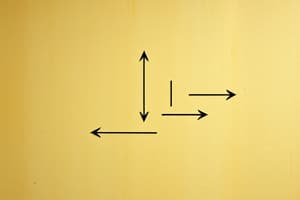Podcast
Questions and Answers
What is the purpose of UML diagrams in software engineering?
What is the purpose of UML diagrams in software engineering?
- To create a visual representation of the system's data flow.
- To provide a standardized way to visualize the system's design. (correct)
- To generate code directly from the diagrams.
- To analyze the system's performance and efficiency.
Which of the following is NOT a design principle discussed in the content?
Which of the following is NOT a design principle discussed in the content?
- Abstraction (correct)
- Decomposition
- Coupling
- Cohesion
Which architecture type is most likely to cause a race condition?
Which architecture type is most likely to cause a race condition?
- Event-driven (correct)
- Data-centric
- Client/server
- Monolithic
What is the main problem caused by a race condition?
What is the main problem caused by a race condition?
Which of the following best describes the purpose of a Class diagram in UML?
Which of the following best describes the purpose of a Class diagram in UML?
What does the notation '0..*' in a UML Class diagram represent?
What does the notation '0..*' in a UML Class diagram represent?
What is the primary purpose of Component diagrams in UML?
What is the primary purpose of Component diagrams in UML?
Which of the following is NOT a benefit of using a use-case diagram?
Which of the following is NOT a benefit of using a use-case diagram?
What type of diagram is used for modeling discrete behavior through finite state transitions?
What type of diagram is used for modeling discrete behavior through finite state transitions?
Which of the following is NOT a valid UML diagram type?
Which of the following is NOT a valid UML diagram type?
In a sequence diagram, what does the timeline represent?
In a sequence diagram, what does the timeline represent?
Which of the following diagrams are considered to be 'structure diagrams'?
Which of the following diagrams are considered to be 'structure diagrams'?
What is meant by 'decomposition' in software design?
What is meant by 'decomposition' in software design?
What is the relationship between cohesion and software design?
What is the relationship between cohesion and software design?
Which of the following best describes 'coupling' in software design?
Which of the following best describes 'coupling' in software design?
In the context of software design, why is low coupling generally preferable?
In the context of software design, why is low coupling generally preferable?
Flashcards
Use-Case Diagram
Use-Case Diagram
A diagram showing actors, use cases, and their relationships in a system.
Purpose of Use-Case Diagrams
Purpose of Use-Case Diagrams
To gather system requirements and illustrate external/internal influences.
State Transition Diagram
State Transition Diagram
A diagram modeling discrete behavior through finite state transitions.
Sequence Diagram
Sequence Diagram
Signup and view all the flashcards
Decomposition
Decomposition
Signup and view all the flashcards
Cohesion
Cohesion
Signup and view all the flashcards
Coupling
Coupling
Signup and view all the flashcards
Cohesion vs Coupling
Cohesion vs Coupling
Signup and view all the flashcards
Race Condition
Race Condition
Signup and view all the flashcards
Mutual Exclusion
Mutual Exclusion
Signup and view all the flashcards
Unified Modeling Language (UML)
Unified Modeling Language (UML)
Signup and view all the flashcards
Structure Diagram
Structure Diagram
Signup and view all the flashcards
Class Diagram
Class Diagram
Signup and view all the flashcards
Behavior Diagram
Behavior Diagram
Signup and view all the flashcards
Study Notes
Software Engineering Course Notes
- Course: CP317A Software Engineering
- Instructor: Shaun Gao, Ph.D., P.Eng.
- Topic: High-level design, part 2 - Week 3-2
Agenda
- Review week 3-1
- Race condition
- Unified Modeling Language (UML)
- UML diagrams
- Structure diagrams (Class, Object, Package, Composite Structure, Component, Manifestation, Deployment, Network Architecture, Profile)
- Behavior diagrams (Use Case, Activity, State Machine, Sequence, Interaction)
- Design principles (3 principles)
- Decomposition
- Cohesion
- Coupling
- Summary
Race Condition
- Event-driven or distributed architectures can cause race conditions
- Race condition: undesirable situation where multiple processes try to modify the same object concurrently
- Problems: data inconsistency
- Prevention techniques: mutual exclusion, semaphores
Unified Modeling Language (UML)
- UML: general-purpose modeling language for software engineering
- Intended to visualize system designs
- Multiple UML diagram types for different purposes
- UML version 2.0 defines 13 diagrams
Design Principles
- Decomposition: Breaking down complex problems into smaller, manageable parts. (e.g., ATM example - splitting into display, balance, deposit, transfer, withdraw)
- Cohesion: How closely related the elements within a module are. High cohesion is better
- Coupling: The dependencies between software components or modules. Low coupling is better
UML: Diagram Types
- Structure Diagrams: show the static structure of the system
- Class Diagram: depicts classes, attributes, operations, and relationships between them; Used for creating static structure
- Object Diagram: depicts specific objects from a class diagram; Show the instances of the classes mentioned in the class diagram
- Package Diagram: depicts how a system is composed into several packages; Shows how the system classifies and arranges each component
- Component Diagram: depicts the software components in a system; Shows the different components in the system in a graphical representation
- Composite Structure Diagram: graphical representation of how parts of a class structure function
- Deployment Diagram: shows the physical deployment of components in a system
- Manifestation Diagram: show how components execute in a system
- Network Architecture Diagram: depicts how systems in a network interact
- Profile Diagram: extends the UML language and notation for a specific domain or project
- Behavior Diagrams: show the system's dynamic behaviour over time
- Use Case Diagram: model the interaction between actors/users and the system's functions. Show function of different components to the user or actor
- State Machine Diagram: model the behavior and states of a component as it progresses through various circumstances (Example: ATM states).
- Sequence Diagram: depicts the interaction among objects in a system; Show the communication/messages exchanged between actors over a sequence
- Activity Diagram: model business logic with flows and actions; shows different phases within the system
- Interaction Diagram: show interactions between objects and their interactions over a timeframe.
Additional Information
- Project Report (SDD) is the starting point for group projects
- Low-level design will be discussed next week
- Help available for group formation
Studying That Suits You
Use AI to generate personalized quizzes and flashcards to suit your learning preferences.




